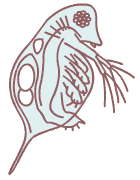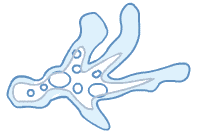Virtual Pond Dip
http://www.microscopy-uk.org.uk/ponddip/index.html
Or
type "Virtual Pond Dip" into google search.
Instructions: A jar shows several organisms that might be found in pond water. When you click on one of the organisms, a page opens with more information. If you scroll over the organisms in the jar, you can see their names.
-Use the back buttons to return to the page with the jar.
-Find the answers to each of the questions by exploring the jar and clicking on each organism.
1. What is the largest organism in the jar? _________________________________
How does this animal capture food? _________________________________
2. What organism is pictured? ________________________________________

Why are these organisms easy to spot in the water? ________________________________
3. What organism is long and stringy and found at the top of the jar? _________________________
4. Another organism is found floating near the top. This sun-shaped organism belongs to a group called ______________________.
5. Identify the organism pictured below: _____________________________________

What is the "string of pearls" structure in the center of it? ______________________________
6. Find the organism shown below. What is it called? ________________________________

What are the paired structures shown (found in females)? ________________________
7. Locate the rotifers. How many are in the jar? _____
Why is this organism called a "wheel animacule" in older textbooks? _________________________
8. Find the volvox in the jar. What is volvox made of? _____________________________________
9. Find the organism shown below. What is it called? _______________________________

Why is it hard to identify these organisms? _____________________
10.Find the organism shown below. What is it called? ____________________________

What are the finger-like protrusions used for? _____________________________
11. Locate the diatoms. What is found on the outside of these organisms? ___________________________
12. Locate the euglena. Is it a single celled organism or multi-celled? ______________________
What is the red spot on it? ____________________
Other Resources on Microorganisms
Ameba Coloring – color the structures of an ameba; pseudopodia, vacuole, nucleus..
Paramecium Coloring – color paramecium, vacuole, mouth pore, macronucleus, cilia..
Euglena Coloring – color euglena; flagella, chloroplast, pellicle
Ameba & Paramecium Lab – view both specimens, compare and draw


